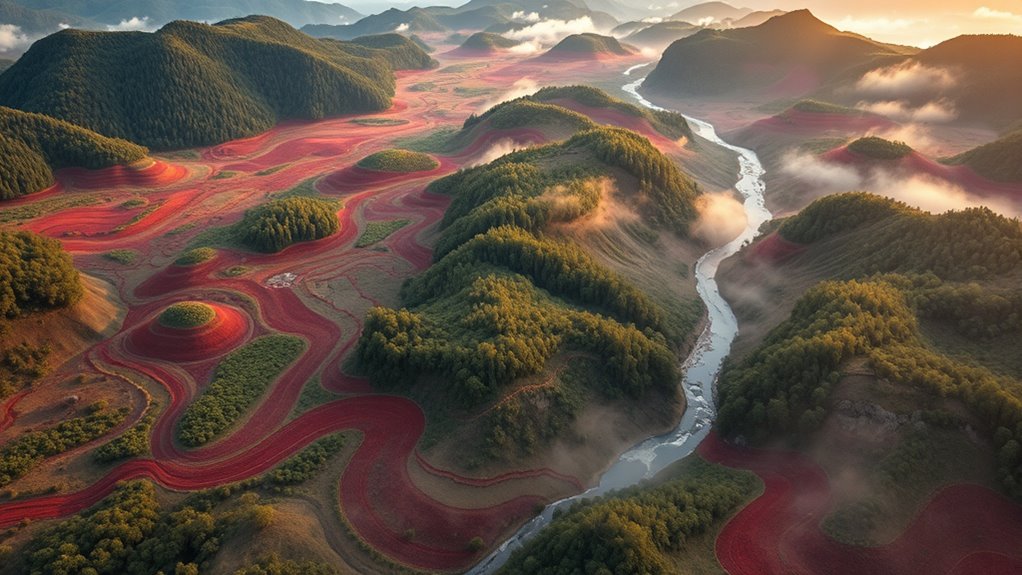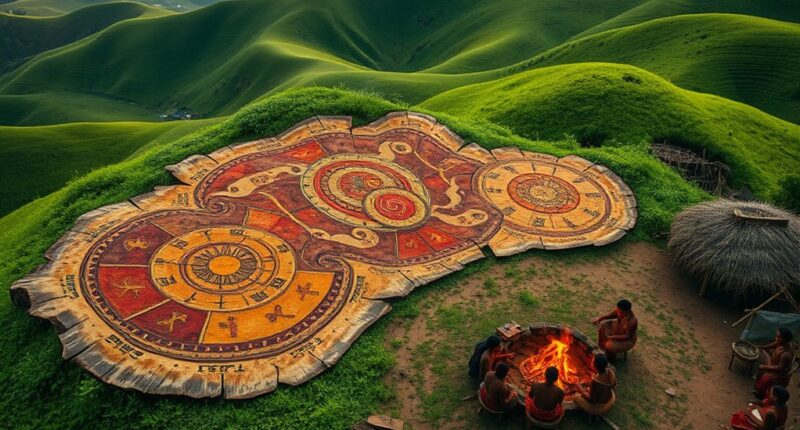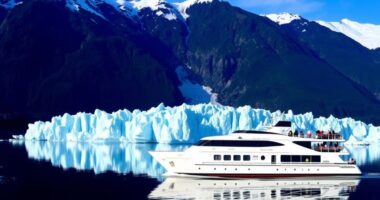Indigenous dream maps are powerful tools that encode spiritual insights, ecological wisdom, and community hopes, offering lessons in climate resilience rooted in centuries of land stewardship. They go beyond ordinary maps, serving as visual guides for cultural preservation, environmental health, and sustainable practices. By understanding these sacred representations, you can learn how indigenous communities integrate spiritual knowledge with ecological decision-making. Continue exploring to discover how these traditions can inspire sustainable futures worldwide.
Key Takeaways
- Indigenous Dream Maps visually encode ecological wisdom and community aspirations, serving as tools for climate adaptation and resilience.
- These maps incorporate traditional storytelling, songlines, and rituals to preserve land rights and cultural knowledge.
- Dream symbolism guides land management, reinforcing spiritual connections and sustainable ecological practices.
- Indigenous practices demonstrate sustainable land stewardship rooted in centuries of experience, offering valuable lessons for climate adaptation.
- Learning from Indigenous Dream Maps promotes community-led resilience and integrates spiritual knowledge into environmental decision-making.

Have you ever considered how Indigenous communities use dreams to understand and protect their land? In many Indigenous cultures, dream symbolism plays an essential role in conveying sacred knowledge about the environment, guiding decisions that uphold cultural preservation. These communities see dreams as more than personal visions; they’re spiritual tools that connect them deeply to their land, ancestors, and future generations. Dream maps, created through this spiritual lens, serve as living records of their relationship with Country, blending cultural stories with ecological wisdom. By translating dreams into visual forms, Indigenous peoples encode insights about climate resilience, land management, and sacred sites, ensuring these lessons endure across generations.
Indigenous dream maps are vibrant, colorful representations that depict ideal village states or landscapes reflecting community aspirations and environmental health. Indigenous women in Odisha, India, exemplify this practice by crafting these maps to visualize a balanced, sustainable village environment. These dream maps are more than art; they’re strategic tools that translate intuitive climate knowledge into formal frameworks for adaptation planning. This approach emphasizes community-led resilience, where Indigenous control and spiritual understanding shape responses to climate impacts. Such maps acknowledge the importance of dream symbolism in capturing complex ecological relationships, making abstract concepts tangible and actionable. They serve as a bridge between traditional knowledge and modern climate policy, fostering culturally relevant solutions that respect Indigenous sovereignty.
Furthermore, Indigenous cartography often incorporates songlines and narrative mapping, which embed cultural meanings into geography beyond Western notions of space. Songlines are living maps, created through storytelling, singing, and ritual, that trace ancestral pathways across the land. These pathways, or Dreaming tracks, are sacred routes connecting places of spiritual significance, natural features, and community sites. Unlike conventional maps, songlines weave lived experience, oral history, and cultural protocols into their fabric, providing a multidimensional understanding of land. They serve as oral and spiritual records of land rights and environmental stewardship, emphasizing the importance of Dreaming stories in maintaining cultural preservation and ecological balance. Dream symbolism also plays a crucial role in guiding community members during ceremonies and environmental decision-making, reinforcing their spiritual connection to the land. Additionally, integrating traditional ecological knowledge with dream symbolism enriches the understanding of ecosystem dynamics and sustainability.
Through these dream maps and story systems, Indigenous communities demonstrate how spiritual practices and cultural symbolism inform sustainable land management. This approach reveals a profound understanding of ecosystems rooted in centuries of experience and spiritual connection. As climate challenges intensify, these Indigenous practices offer valuable lessons in resilience, emphasizing the importance of respecting Dream symbolism and cultural knowledge. By learning from these communities, we gain insight into how indigenous ways of knowing can inform broader efforts to protect and preserve land, ensuring that traditional wisdom continues to guide sustainable futures.
Frequently Asked Questions
How Do Indigenous Dream Maps Differ From Western Cartography?
You’ll notice that indigenous dream maps differ from Western cartography because they use symbolic representation and prioritize spiritual significance over precise measurements. Instead of straight lines and cardinal directions, they focus on storytelling, cultural values, and ecological connections. These maps are dynamic, incorporating environmental changes and spiritual beliefs, helping communities preserve their identity and adapt to climate challenges, unlike Western maps that emphasize technical accuracy and Euclidean geometry.
What Role Do Oral Traditions Play in Creating Dream Maps?
Imagine weaving a vibrant tapestry where every thread tells a story—that’s what oral traditions do in creating dream maps. You use cultural storytelling and spiritual symbolism to craft living, breathing maps rooted in ancestral wisdom. These stories act as guiding stars, embedding landmarks, resources, and sacred sites within your community’s collective memory. Through this oral artistry, you transform space into a dynamic, spiritual landscape that connects past, present, and future.
Can Dream Maps Adapt to Climate Change Impacts?
Yes, dream maps can adapt to climate change impacts through cultural resilience and adaptive storytelling. You can update these maps by incorporating new environmental data, reflecting changes like shrinking forests or altered water sources. This process strengthens your community’s ability to respond proactively, preserving traditional knowledge while addressing current challenges. By continuously integrating evolving climate realities into the maps, you guarantee they remain relevant tools for sustainable adaptation and cultural preservation.
How Do Communities Ensure the Preservation of Dream Map Knowledge?
You guarantee the preservation of dream map knowledge through cultural resilience and active knowledge transmission. By engaging elders as mentors and involving younger generations in storytelling, songs, and ceremonies, you keep traditions alive. Incorporating digital tools like GIS while respecting cultural frameworks helps document and protect these maps. Community-led initiatives and asserting indigenous authorship further strengthen the continuity of this essential cultural knowledge across generations.
Are Dream Maps Recognized Officially in Environmental Planning?
You should know that dream maps aren’t officially recognized in environmental planning yet. There’s no formal legal recognition, which limits their influence in policy processes. However, they’re valuable for cultural integration, blending Indigenous knowledge with environmental concerns. Advocacy and community efforts aim to change this, pushing for recognition that respects both their cultural significance and practical role in land rights and conservation. Increased awareness could help embed dream maps into formal frameworks someday.
Conclusion
By exploring Indigenous Dream Maps, you see how communities blend tradition and climate awareness, challenging the idea that modern science is the only way to understand our world. These maps reveal that indigenous knowledge isn’t just folklore—it’s a crucial, evolving tool for resilience. Embracing this perspective, you realize that learning from these communities could inspire new ways to address climate change, proving that ancient wisdom still holds powerful truths for our future.








